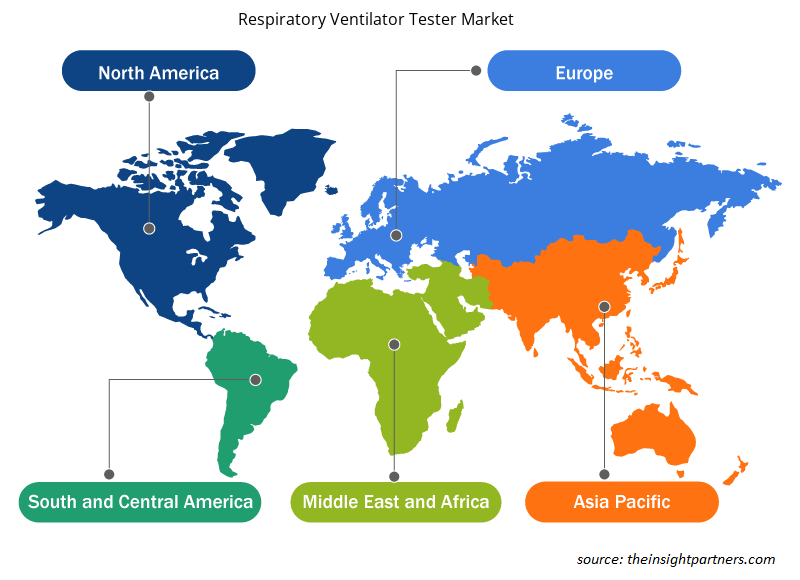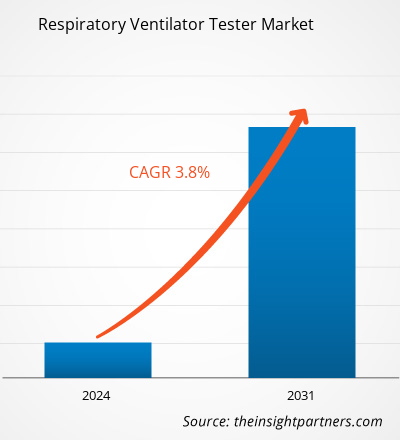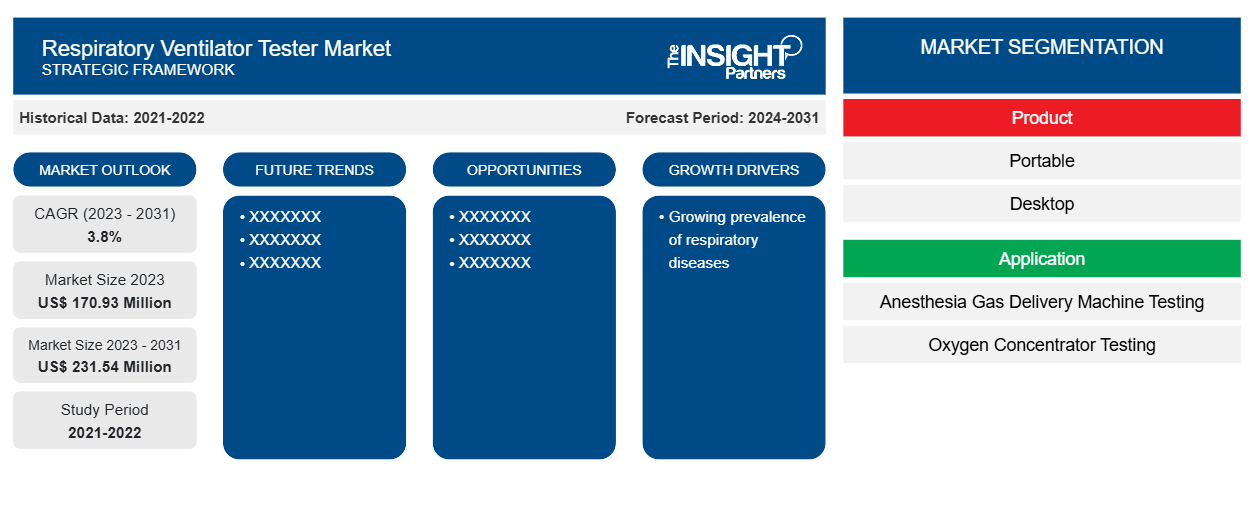Si prevede che la dimensione del mercato dei tester per ventilatori respiratori raggiungerà i 231,54 milioni di dollari entro il 2031, rispetto ai 170,93 milioni di dollari del 2023. Si prevede che il mercato registrerà un CAGR del 3,8% nel 2023-2031. La crescente prevalenza di malattie respiratorie, la crescente domanda di tester per ventilatori negli ospedali e i progressi tecnologici nei tester per ventilatori per la misurazione dei parametri vitali rimarranno probabilmente le tendenze chiave del mercato dei tester per ventilatori respiratori.
Analisi di mercato dei tester per ventilatori respiratori
Il crescente peso delle malattie respiratorie e la popolazione sempre più anziana soggetta a diversi disturbi respiratori stanno aumentando la crescita del mercato. Ad esempio, secondo i dati pubblicati nell'articolo di Jama Network Open a dicembre 2023, la prevalenza della BPCO nel 2020 tra uomini e donne è stata stimata al 10,6%, ovvero circa 480 milioni di casi. Si prevede che i casi di BPCO aumenteranno di 112 milioni, raggiungendo un totale di 592 milioni entro il 2050, soprattutto tra le donne e nelle regioni a basso e medio reddito. Pertanto, si prevede che l'enorme peso della BPCO, che è una delle principali malattie respiratorie, aumenterà la domanda complessiva per il suo trattamento e richiederà tester per ventilatori, aumentando così il mercato dei tester per ventilatori respiratori nel periodo di previsione.
Panoramica del mercato dei tester per ventilatori respiratori
Il Nord America è il mercato più grande per la crescita del mercato dei tester per ventilatori respiratori, con gli Stati Uniti che detengono la quota di mercato maggiore seguiti dal Canada. Si prevede che fattori come la crescente prevalenza di disturbi respiratori, i progressi tecnologici nel settore dei dispositivi medici e l'aumento dell'invecchiamento della popolazione incline a diverse malattie respiratorie stimoleranno ulteriormente il mercato complessivo dei tester per ventilatori respiratori nordamericani. Ad esempio, secondo l'articolo pubblicato su Aging and Disease nell'agosto 2023, le infezioni respiratorie erano un problema di salute significativo tra la popolazione anziana, in particolare durante la pandemia di COVID-19 nel 2020. L'aumento dei tassi di mortalità e morbilità è stato osservato principalmente tra la popolazione anziana sopra i 65 anni. Il normale processo di invecchiamento tra la popolazione anziana nei polmoni aumenta la vulnerabilità alle infezioni respiratorie a causa del danno cellulare e dell'accumulo di senescenza. Quindi, la crescente popolazione anziana che soffre di infezioni respiratorie richiederà un tester per ventilatori, che sta ulteriormente guidando il mercato dei tester per ventilatori respiratori nordamericani.
Personalizza questo report in base alle tue esigenze
Riceverai la personalizzazione gratuita di qualsiasi report, comprese parti di questo report, o analisi a livello nazionale, pacchetto dati Excel, oltre a usufruire di grandi offerte e sconti per start-up e università
-
Scopri le principali tendenze di mercato in questo rapporto.Questo campione GRATUITO includerà analisi di dati che spaziano dalle tendenze di mercato alle stime e alle previsioni.
Driver e opportunità di mercato per i tester dei ventilatori respiratori
La crescente prevalenza di disturbi respiratori che richiedono un sistema di test per ventilatori respiratori favorisce il mercato
Si prevede che la crescente prevalenza di malattie respiratorie croniche, come la broncopneumopatia cronica ostruttiva (BPCO) e l'asma , stimolerà la domanda di tester per ventilatori respiratori. Inoltre, fattori come l'urbanizzazione e l'espansione industriale hanno portato a un aumento dell'inquinamento atmosferico, con conseguenti maggiori infezioni respiratorie. Durante la pandemia, la domanda di questi ventilatori respiratori è stata ulteriormente enfatizzata nel trattamento di gravi disturbi respiratori. Questa impennata della domanda ha fatto aumentare la necessità di servizi e apparecchiature di terapia intensiva come i tester per ventilatori, che a loro volta stanno incrementando la crescita complessiva del mercato dei tester per ventilatori respiratori.COPD), and
Progressi tecnologici nel tester del ventilatore respiratorio: un'opportunità nel mercato dei tester del ventilatore respiratorio
Il mercato dei tester per ventilatori respiratori include la produzione, la distribuzione e l'utilizzo di apparecchiature di test specializzate destinate a misurare le prestazioni e l'accuratezza dei ventilatori respiratori. Questi tester sono dispositivi essenziali utilizzati per valutare la funzionalità, la sicurezza e la conformità dei sistemi di ventilazione utilizzati in strutture sanitarie come ospedali, cliniche e pronto soccorso. Aiutano a simulare varie condizioni respiratorie per garantire che i ventilatori forniscano le frequenze respiratorie, i volumi correnti e le concentrazioni di ossigeno appropriati. I progressi in questi dispositivi, come lo sviluppo di sistemi di test portatili, automatizzati e intuitivi con capacità di misurazione avanzate e strumenti di analisi dei dati, stanno guidando la crescita del mercato. Le aziende stanno lanciando nuovi prodotti con nuovi progressi. Ad esempio, a marzo 2023, Vitalograph, uno sviluppatore e produttore di dispositivi diagnostici respiratori, ha lanciato la sua serie di test della funzione polmonare VitaloPFT per l'uso nell'assistenza secondaria. I tester per ventilatori respiratori svolgono un ruolo importante nella conformità normativa, nella garanzia della qualità e nella sicurezza del paziente rilevando potenziali malfunzionamenti, errori di calibrazione e deviazioni delle prestazioni. Pertanto, si prevede che il crescente sviluppo delle tecnologie di ventilazione darà impulso al mercato complessivo dei dispositivi di analisi delle malattie respiratorie.Vitalograph, a developer and producer of respiratory diagnostic devices launched its VitaloPFT Pulmonary Function Testing Series for use in secondary care. Respiratory ventilator testers play an important role in regulatory compliance, quality assurance, and patient safety by sensing potential malfunctions, calibration errors, and performance deviations. Hence, the increasing advent of ventilator technologies is expected to boost the overall respiratory disease tester market.
Analisi della segmentazione del rapporto di mercato del tester del ventilatore respiratorio
I segmenti chiave che hanno contribuito alla derivazione dell'analisi di mercato dei tester per ventilatori respiratori sono il prodotto, l'applicazione e gli utenti finali.
- In base al prodotto, il mercato dei Respiratory Ventilator Tester è segmentato in portatile, desktop e altri. Il portatile ha detenuto una quota di mercato maggiore nel 2023. La quota maggiore può essere attribuita alla crescente adozione di ventilatori respiratori portatili grazie alla loro facilità di utilizzo e alle caratteristiche di portabilità.
- Per applicazione, il mercato è segmentato in Test delle macchine per l'erogazione del gas anestetico, Test dei concentratori di ossigeno e altri. Il segmento dei test delle macchine per l'erogazione del gas anestetico ha detenuto la quota maggiore del mercato nel 2023.
- In base all'utente finale, il mercato è segmentato in Ospedali e cliniche specialistiche, Centri chirurgici ambulatoriali, Strutture di assistenza domiciliare e Altri. Il segmento ospedaliero e cliniche specialistiche ha detenuto la quota di mercato maggiore nell'anno 2023.
Analisi della quota di mercato dei tester per ventilatori respiratori per area geografica
L'ambito geografico del rapporto di mercato sui tester per ventilatori respiratori è suddiviso principalmente in cinque regioni: Nord America, Asia Pacifico, Europa, Medio Oriente e Africa e Sud America/Sud e Centro America.
Il Nord America ha dominato il mercato dei tester per ventilatori respiratori. La crescita del mercato può essere attribuita alla crescente prevalenza di malattie respiratorie, ai progressi nei sistemi di ventilazione negli ospedali e alla rapida crescita del settore dei dispositivi medici. Inoltre, si prevede che la domanda di un tester per ventilatori respiratori in contesti di assistenza domiciliare e la sua maggiore adozione nei prossimi anni a causa del crescente carico di malattie respiratorie stimoleranno ulteriormente il mercato dei tester per ventilatori respiratori nei paesi del Nord America.
Approfondimenti regionali sul mercato dei tester per ventilatori respiratori
Le tendenze regionali e i fattori che influenzano il mercato dei tester per ventilatori respiratori durante il periodo di previsione sono stati ampiamente spiegati dagli analisti di Insight Partners. Questa sezione discute anche i segmenti e la geografia del mercato dei tester per ventilatori respiratori in Nord America, Europa, Asia Pacifico, Medio Oriente e Africa e America meridionale e centrale.

- Ottieni i dati specifici regionali per il mercato dei tester per ventilatori respiratori
Ambito del rapporto di mercato del tester del ventilatore respiratorio
| Attributo del report | Dettagli |
|---|---|
| Dimensioni del mercato nel 2023 | 170,93 milioni di dollari USA |
| Dimensioni del mercato entro il 2031 | 231,54 milioni di dollari USA |
| CAGR globale (2023-2031) | 3,8% |
| Dati storici | 2021-2022 |
| Periodo di previsione | 2024-2031 |
| Segmenti coperti |
Per Prodotto
|
| Regioni e Paesi coperti |
America del Nord
|
| Leader di mercato e profili aziendali chiave |
|
Densità degli attori del mercato: comprendere il suo impatto sulle dinamiche aziendali
Il mercato dei tester per ventilatori respiratori sta crescendo rapidamente, spinto dalla crescente domanda degli utenti finali dovuta a fattori quali l'evoluzione delle preferenze dei consumatori, i progressi tecnologici e una maggiore consapevolezza dei vantaggi del prodotto. Con l'aumento della domanda, le aziende stanno ampliando le loro offerte, innovando per soddisfare le esigenze dei consumatori e capitalizzando sulle tendenze emergenti, il che alimenta ulteriormente la crescita del mercato.
La densità degli operatori di mercato si riferisce alla distribuzione di aziende o società che operano in un particolare mercato o settore. Indica quanti concorrenti (operatori di mercato) sono presenti in un dato spazio di mercato in relazione alle sue dimensioni o al valore di mercato totale.
Le principali aziende che operano nel mercato dei tester per ventilatori respiratori sono:
- Gruppo BC Internazionale
- Megnamed,
- TSI Incorporata,
- IMT Analytics AG,
- Rigel Medico
- Società Fluke
Disclaimer : le aziende elencate sopra non sono classificate secondo un ordine particolare.

- Ottieni la panoramica dei principali attori del mercato dei tester per ventilatori respiratori
Notizie di mercato e sviluppi recenti sui tester per ventilatori respiratori
Il mercato dei tester per ventilatori respiratori viene valutato raccogliendo dati qualitativi e quantitativi dopo la ricerca primaria e secondaria, che include importanti pubblicazioni aziendali, dati associativi e database. Di seguito è riportato un elenco degli sviluppi nel mercato dei tester per ventilatori respiratori:
- Armstrong Medical, produttore britannico di prodotti respiratori per l'uso in terapia intensiva e in ambito perioperatorio, si unirà al padiglione ABHI UK a MEDICA 2021 per lanciare i suoi circuiti ventilatori riscaldati che migliorano la terapia. (Fonte: Armstrong Medical, comunicato stampa/sito Web aziendale/newsletter, ottobre 2021)
- Superior Sensor Technology ha annunciato una tecnologia proprietaria di sensori di pressione che migliora il tempo di risposta ed elimina l'impatto del rumore di sistema nei ventilatori e nelle apparecchiature per ossigeno ad alto flusso, consentendo la riduzione della dissincronia paziente-ventilatore. (Fonte: Superior Sensor Technology, comunicato stampa/sito Web aziendale/newsletter, marzo 2023)
Copertura e risultati del rapporto di mercato sui tester dei ventilatori respiratori
Il rapporto "Dimensioni e previsioni del mercato dei tester per ventilatori respiratori (2021-2031)" fornisce un'analisi dettagliata del mercato che copre le seguenti aree:
- Dimensioni e previsioni del mercato a livello globale, regionale e nazionale per tutti i segmenti di mercato chiave coperti dall'ambito
- Dinamiche di mercato come fattori trainanti, vincoli e opportunità chiave
- Principali tendenze future
- Analisi dettagliata delle cinque forze PEST/Porter e SWOT
- Analisi di mercato globale e regionale che copre le principali tendenze di mercato, i principali attori, le normative e gli sviluppi recenti del mercato
- Analisi del panorama industriale e della concorrenza che copre la concentrazione del mercato, l'analisi della mappa di calore, i principali attori e gli sviluppi recenti
- Profili aziendali dettagliati
- Analisi storica (2 anni), anno base, previsione (7 anni) con CAGR
- Analisi PEST e SWOT
- Valore/volume delle dimensioni del mercato - Globale, Regionale, Nazionale
- Industria e panorama competitivo
- Set di dati Excel
Report recenti
Rapporti correlati
Testimonianze
Motivo dell'acquisto
- Processo decisionale informato
- Comprensione delle dinamiche di mercato
- Analisi competitiva
- Analisi dei clienti
- Previsioni di mercato
- Mitigazione del rischio
- Pianificazione strategica
- Giustificazione degli investimenti
- Identificazione dei mercati emergenti
- Miglioramento delle strategie di marketing
- Aumento dell'efficienza operativa
- Allineamento alle tendenze normative























 Ottieni un campione gratuito per - Mercato dei tester per ventilatori respiratori
Ottieni un campione gratuito per - Mercato dei tester per ventilatori respiratori